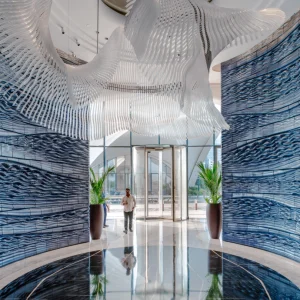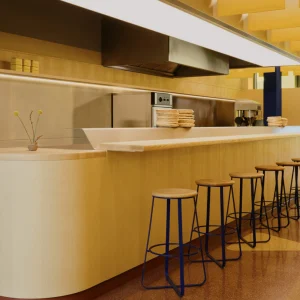Edited By Jill Enwistle
THE EMPHASIS on lit effect rather than the luminaires themselves, long advocated by lighting designers, has become widely adopted. The upshot is that much architectural lighting is now artfully concealed in floor troughs, suspended ceiling panels, coves and cornices, especially in leisure and retail environments. The irony is that when the approach goes overboard potentially it can be to the detriment of the overall lit effect.
‘There has been a trend to eliminate visible lighting, to the point where we are sometimes fighting to introduce accent lighting – which is essential if the overall effect isn’t to appear too flat, which it does if you only have concealed lighting,’ says Nicholas Belfield, partner of DPA Lighting Consultants.
As ever in lighting, the optimum results come from layering and balance.
Another outcome to emerge from this trend, particularly in hotel environments, is the overt use of lighting in the form of customised and sculptural light fittings and installations, which act as dramatic focal points, foils to blandness. Occasionally the two techniques, overt and concealed lighting, come together with the sources integrated into these structures.
The approach also involves commissioned sculptures and interior elements that are artfully lit so that structure and illumination combine to create the centrepiece.
Just as the chandelier has always glittered in these environments, these are creations to arrest the eye and drop the jaw – or at least signal the exclusivity of the surroundings.
‘Special lighting features are definitely more prevalent across all types of projects, with hotels being at the forefront of this trend,’ says Belfield.
‘There are multiple reasons for this – for one, lighting becoming more concealed and the move away from visible architectural lighting, including the desire from many designers to avoid downlights and all visible forms of technical architectural lighting. Technological developments, the reduction in size of LEDs, tuneable white technology and a more sophisticated understanding of lighting by architects and interior designers have also all driven this.’
The latest addition to the Mandarin Oriental portfolio in London’s Mayfair features a series of illuminated features, large and small, throughout the hotel as part of a lighting scheme by DPA Lighting Consultants working with Tokyo-based mutlidisciplinary studio Curiosity.
Designed by Rogers Stirk Harbour + Partners (RSHP) and situated on Hanover Square (Mayfair’s oldest), the boutique spa hotel is built using a Vierendeel structure to maximise internal space. The allows for spacious guestrooms and suites, and a dramatically sunken yet daylit restaurant – one of two restaurants by awardwinning chef American Korean Akira Back, his first in the UK – beneath the ground floor lobby.
With their aim of creating ‘a hub of nature and art’, Curiosity – whose work has always shown a strong lighting sensibility – collaborated with DPA to ensure that even if lighting features had been created or selected on an aesthetic basis, the technical spec was rigorous and fittings produced the optimum lit effect.
Akira Back restaurant
Located below lobby level the Akira Back all-day restaurant, serving modern Japanese food, has a tripleheight sky roof and a marble, circular staircase leading into the space. Despite the drama of marble entryway and soaring height, it has an intimate feel with mellow natural tones and warm lighting.
Dominating the space is a steam-bent wood wall sculpture by British artist Charlie Whinney. Lighting it was an exercise in exactitude. All illumination comes from spotlights located on the facing wall. The original concept was to use a control system so that the shadow pattern formed by the sculpture changed over time, and this determined the location and angles of the individual spots.
As so often, the control system didn’t materialise in the final scheme so in the end positioning was based on both the original calculations and precise onsite adjustment. It was crucial not to create glare to the diners so focusing was tested out with someone sitting in every seat.
Alongside that practicality, it was also important to reveal the sculpture to its best advantage rather than overwhelming or flattening out the structure with too much light or shadowing. A mix of narrow and wide beam spots were used to create a pleasing play of light and shadow. ‘It needed to be a more delicate approach,’ says Nicholas Belfield, partner of DPA Lighting Consultants. ‘A soft, gentle light.’
Spa pool
 Each of the myriad luminaires by the 25m-long pool has an individual LED
Each of the myriad luminaires by the 25m-long pool has an individual LED
Deep in the heart of the hotel, the 25m pool features custom mosaic tiles that gradate from a refreshing light blue at one end to a soothing dark tone at the other, changing the colour of the water. A dark space in contrast to the warmly lit and honeyed tones of the adjacent relaxation area, the key to the lighting was exploiting the reflectivity of the surfaces to the full.
The hand-blown glass wall fittings were chosen by the interior designer with the technical spec carried out by DPA. Each of the myriad luminaires has an individual LED (warm 2700K). They are reflected not only by the water and the walls themselves but also by the mirror Barrisol ceiling to create a threedimensional, infinity effect. ‘The multiple fittings create a magical space,’ says Belfield.
The aim was to avoid too much lighting on the pool itself, which would dilute the dramatic reflections from the wall fittings. A series of concealed – not visible to anyone standing on the edge – underwater linear LED fittings is used along the edges to provide a soft glow. The LEDs were specified to be low glare and more discreet than standard fittings.
Spa reception
 Downlighting from miniature slot sources heightens the reflections from the gold, rippled metal flooring
Downlighting from miniature slot sources heightens the reflections from the gold, rippled metal flooring
Nobody would argue that there’s anything fancy-schmancy about the lighting concept for the ‘bird’s nest’ feature: it is a straightforward mix of uplighting and downlighting.
The uplighting is from inside the base to create light and shadow patterns on the ceiling, while the carefully calibrated downlighting from miniature slot sources above balances the glow effect and heightens the reflections from the gold, rippled metal flooring, suggesting water. Together they create patterning in three dimensions. Even though the metal substitutes for what was originally a water feature, the effect is still powerful.
ABar lounge
 Lighting needed to counter the simple, strong geometry of the interior elements
Lighting needed to counter the simple, strong geometry of the interior elements
One of the features of spaces throughout the hotel is the contrast in brightness levels between adjacent areas, in this case the moody dark bar juxtaposed with the daylit atrium restaurant and lobby. A relaxation space that goes from day to night, the brief was cosy sanctuary.
The overall effect of the interior design is created with opulent fabrics, golden mesh and dark finishes. However, the lighting approach needed to counter the simple, strong geometry of the interior elements. ‘There were a lot of rich materials but very minimal design so soft light was needed to take the edge off,’ says Belfield.
Aside from concealed lighting behind the quadrilateral decorative panels around the perimeter, the key feature of the space is the suspended mesh ceiling elements.
‘We explored various options but uplighting from the bottom of the mesh gave the best effect, using 5mm-wide, diffused LEDs.’ Again attention to detail ensured the precise effect with theatrical black wrap tape used on the bottom to remove any light spill and focus the light exclusively upwards.
The space is further softened with concealed dim-towarm LED lighting to change from relaxed ambience during the day to a dark, intimate space with richer, golden light late at night.
Dosa restaurant
 The central metal structure – evoking a giant cooker hood – acts as both the key interior element and light source
The central metal structure – evoking a giant cooker hood – acts as both the key interior element and light source
With its uncompromising gritty aesthetic, the lighting has to work hard to suggest the atmosphere of exclusive fine dining. Offering a Korean-inspired tasting menu, the restaurant seats just 14 diners at the chef’s table.
As lighting can affect perception of taste, it was designed in consultation with the chef and maître d’. The lighting scene slowly changes over the three hours of each sitting (17 courses), calibrated to work with the food and stage of the process. While the downlights to the preparation area and spots on the dining area are standard solutions, the central metal structure – evoking a giant cooker hood – acts as both the key interior element and light source.
A band of LEDs at the bottom of the structural leaves both animates and softens them. Unusually, the two key sources over the dining area also have a different colour temperature range. The sources on the structure are tuneable from a warm 2000K to a very cool 5000K, while the spots directed at the dining area change between 2500K and 3500K.
‘The overall design makes you feel as if you have been allowed behind the scenes into the kitchen with direct access to the chef,’ says Belfield. ‘The tuneable white LEDs allowed us to play with colour temperatures and the diners’ perception of the spaces.’





